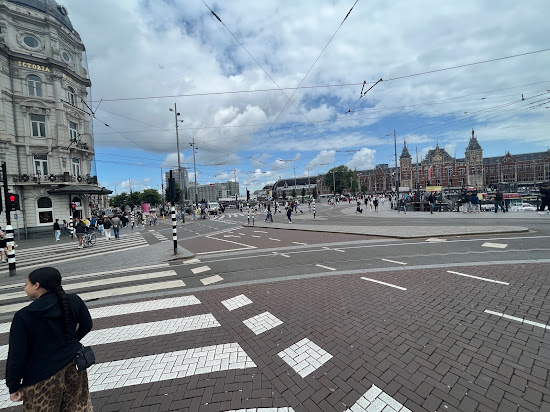Amsterdam - Overall Reflection
It has been a long week! Since my last post, our group has made it to Amsterdam and we have been here for about a week. As we were on the series of trains it takes to get from the airport to our hostel, I was very excited to be back in the big city. (Side note: I have 'been to' Amsterdam before, and have even biked around the city for a bit. However, that was only for one day on a layover).
As we finished the final segment (the walk from the Metro station to our hostel) my first impression was how differently their streets were set up. The big visual difference of course is that most of the bike lanes here are red. The second was how 'chaotic' it feels. When we were walking around the Amsterdam Central Station area, I couldn't help but notice just how many people were there. Even outside of that area, there can be huge waves of bikes which can be a little intimidating at first. The third was that the intersections are a lot different (most have protected left-hand turns for bikes!). Another difference is that the signals in Amsterdam are also posted at the stop line (and not across the intersection).
 |
| Traffic signal posted at the 'near side' of the intersection |
I think this is an interesting design choice. Our professor said the thinking behind this was that it forces people to stop before the stop line. Therefore, if they want to be able to read the signal, they have to stop in the correct location. I feel like there might be some downsides to this though...
Anyways, after settling into our new hostel and a night's rest, we met with Meredith Glaser of the University of Amsterdam. She introduced us to a scavenger hunt (which I will probably go into more detail in a separate post) before we picked up our bikes.
We had to get to a bike rental shop across town to pick up our bikes, so a few of us took this as an opportunity to walk around the city for a bit (to get an on-the-foot perspective). We collectively noticed how the streets are laid out much differently here. In Amsterdam, the central core is surrounded by a ring of canals. Navigating through that makes it a little hard for someone who is unfamiliar with the area. As I hinted at before, the closer we got to the central station (no matter which street we chose) it felt much more chaotic. Even with the twists and turns we made it on time to the bike rental shop to get our bikes.
 |
| Lots going on at this intersection by Central Station. Bikes, cars, trams (streetcars), and pedestrians all interact. |
While not related to actual bike infrastructure, it was interesting how this rental shop had a wide variety of bikes. The ones at this shop were set up and geared a lot more similar to what I would ride back home. Gone were the pedal breaks and basket. The people at the bike shop also provided us with a CHAIN lock. They emphasized that if you were going to lock the bike for more than 20 minutes, they highly recommend that we use the chain lock. Most civilian bikes I have seen here also have chain locks, so I'm guessing bike theft is a thing here.
Over the next few days we:
- Worked on the scavenger hunt
- Woke up to Storm Poly (supposedly the worst summer storm in the Netherlands in recorded history!).
- After the storm died down we treaded through the streets (at the time containing many downed trees).
- The trams were down in our area, and we saw a crazy 7-tram backup in the middle of the street
- We learned even more about Amsterdam's bike history (with a brief lecture and bike tour) from a co-author of a book.
- Met up with Ronald the traffic engineer from Utretct (who will be hosting us when we visit there in a few days)
 |
| A fallen tree from the storm blocking a bridge |
Biking to the suburbs
 |
| Biking down the advisory bike lane space |



Very interesting to see these initial impressions of the Dutch system and how things change over time or get reinforced.
ReplyDelete